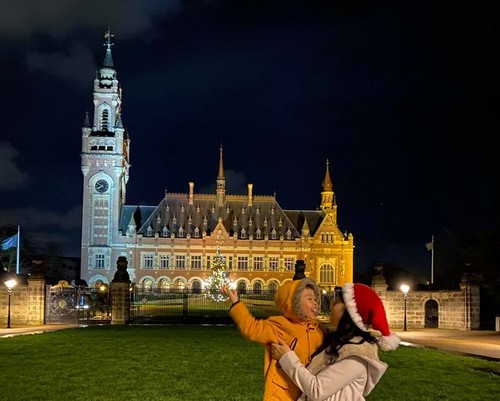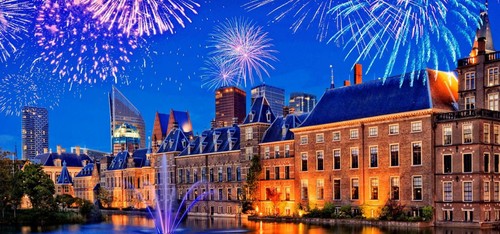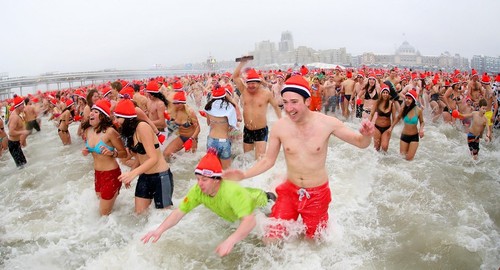 Thuy and her son pose in front of the International Court of Justice in the Hague, the Netherlands, on Christmas' Eve of 2020. Thuy and her son pose in front of the International Court of Justice in the Hague, the Netherlands, on Christmas' Eve of 2020. |
Ngoc Diep: Happy New Year, Thuy. Welcome to VOV24/7 on 104 FM. You’ve been living in Den Haag or the Hague with your family over the past 1 and a half year. What do you find out about the Dutch New Year?
Thu Thuy: Hello, thank you for having me today. During my stay here, I find it interesting that Dutch people have very nice traditions. At this time of year, they have some routines include eating deep fried dough balls known as Olliebollen, setting fireworks, and diving into the North Sea, lakes or canals.
 2019 Christmas photo of Thuy's family 2019 Christmas photo of Thuy's family |
Ngoc Diep: Oh, I’ve heard a lot about the Dutch tradition of setting fireworks in the New Year. It’s famous. Tell us more about that please.
Thu Thuy: Sure. New Year's Day is a public holiday so it is a day off for the general population and schools and most businesses are closed. On this occasion, Dutch people like to set fireworks as a ritual to mark the New Year. This is considered the most common New Year's Day symbol in the Netherlands. Fireworks are traditionally set off at midnight of New Year’s Eve. In large towns and cities fireworks are set off continuously for one to two hours. This results in smog that can take many hours to clear and leaves a layer of red paper snippets. Many Dutch people spent a month salary on plenty of fireworks. Last year, we had a good chance to immerse ourselves in this special atmosphere by driving around the city up to the Scheveningen Beach. Like many expats staying in the Netherlands during the holidays, we were surprised and excited to see the chaos on all the streets and roads on New Year's Eve. It is funny to see the usual calm and gentle Dutch people become exceptionally noisy and gaily for just a special day, and the next day they come back to their peaceful manner as nothing ever happen. Dutch people’s passion for fire and explosion smoke is not limited to firework only. They also enjoy attending bonfires and blowing up milk churn.
 New Year's Eve in the Hague. Photo: thehagueinternationalcentre.nl New Year's Eve in the Hague. Photo: thehagueinternationalcentre.nl |
Ngoc Diep: It’s amazing, isn’t it?
Thu Thuy: Oh, yes. Giant bonfires an annual tradition on New Year's Eve all around Europe and the Netherlands is no exception. People skillfully piled up the woods or dead Christmas trees to make the great fire. Bonfire is a chance for all friends to gather together and share the joy and welcoming the New Year. The luscious bonfires can be found on the shores of Scheveningen and Duindorp where the fire could be as high as 35 metres.
Ngoc Diep: Wonderful. I wish to see that with my own eyes.
Thu Thuy: And about blowing up milk churn, which is known as carbidschieten, you can imagine this activity is something similar to shooting a small canon. This tradition involves tossing a bunch of carbide into an old fashioned milk churn with water and waiting for the lid, which are often made from footballs, to blast off the top, creating an impressive fireball in the process.
Ngoc Diep: Very impressive! Since the Netherlands is surrounded by water and canals, most of Dutch are good at swimming. Are there any activities related to water on their New Year’s Day?
Thu Thuy: Yes, you are right. Dutch people are very good at swimming. Every child has their swimming diploma certificate at very young age. That explains why another unique Dutch tradition is diving into water on New Year Day. Participants dive into the North Sea, lakes or canals and swim a small distance with the tens of thousands of others attempting to shake off their hangover. These events are televised and the participants are seen as heroic given that it is very cold in the Netherlands on January 1. They usually wear orange pom-pom hats, creating an impressive and unique orange mass at the sea.
 New Year's Dive at Scheveningen Beach in the Netherlands. Photo: www.flickr.com/photos/rud-gr New Year's Dive at Scheveningen Beach in the Netherlands. Photo: www.flickr.com/photos/rud-gr |
Ngoc Diep: What a nice tradition. How about Dutch food for holidays? What do they eat on New Year’s Eve?
Thu Thuy: The special food for New Year includes special types of sweet dough. These include olliebollen (oil balls a kind of donut made with or without raisins and served with icing sugar) and Appelflappen (small deep fried pies filled with apple).
 Yummy "Olliebollen" of the Dutch people. Yummy "Olliebollen" of the Dutch people. |
Ngoc Diep: Very yummy. Do they have any reasons for eating this kind of food?
Thu Thuy: This tradition of eating foods containing a lot of fat may go back to the time of the pre-Kristen Germany goddess Perchta (Bertha). People believe that Perchta would fly across the sky with evil spirits in the darkest part of winter and try to cut open the stomachs of anybody she met. However, her knife would slide off the people who had been eating fatty foods.
Ngoc Diep: Oh, I see. That’s why Dutch people, well-known for their healthy lifestyles, still keep this tradition of eating fatty foods on New Year’s Day. So in general, what do you think about Dutch traditions?
Thu Thuy: I find that Dutch traditions are delightful and enjoyable. Their tradition reflects the Dutch characteristic as brave, strong and friendly. Their unique traditions increase the bonding between people from different cultures.
Ngoc Diep: Thank you, Thuy, for sharing your stories. We wish you and your family all the best for the New Year. Please take good care of yourself and stay safe. Hopefully we’ll get over the COVID-19 pandemic very soon.
Thu Thuy: Thank you, too. We really hope the pandemic will be over soon. Happy New Year and best wishes to all.